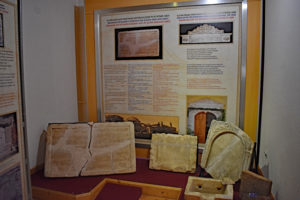Pai is a town in the Mae Hong Son Province of northern Thailand. It sits in a valley on the banks of the Pai River and is a well-known backpacker destination.
The first stop on our half-day tour was Wat Pra That Mae Yen, a large white statue of Buddha built high on a hill and visible from miles around. We took the easy option and drove to the bottom of the stairs although fitter younger backpackers were trekking the 2 miles from town. However, knowing it was then 392 steps to the top we wanted to conserve our energy. However, the steps were all flat and reasonably even and only a couple of ‘puff stops’ were needed. It was surprisingly peaceful at the top as it was early, and we walked around the brick and cement image and admired the views over Pai. At 10.30am, it was chilly and as we had to take shoes off to walk around the top, the tiled floor which was still in the shade, was very cold on our feet. The image was built only a few years ago and the site was chosen as there was a previous old temple at the bottom.
Back down, we visited the small original temple. It’s not known how long it has been there, but on the wall above the door, were graphic images depicting your fate if you failed to obey the Buddhist Precepts, which are similar to the 10 commandments.
At a second large temple, Wat Nam Hoo, devotees were preparing for some kind of celebration. Multi-coloured paper streamers were being hung from both the ceiling of a tent outside the wat and inside. Each had a dangling string which led back to the main Buddha image and people sit underneath them to feel the connection. Tee-pee like structures, made from poles, had explosions of paper protruding from the top whilst rows of cigars or candles adorning the sides in neat rows – the symbolism of this was less clear. The Wat is noted for its Buddha image whose top knot comes off to reveal water (a bit like a miracle). Outside the main temple was a duck pond and a building dedicated to Princess Supankalaya (the sister of King Narasuan who died in 1605).
Next stop was the Chinese Village. This turned out to be a rather tacky set of Chinese shops and stalls selling all manner of Chinese goods, an archery stand, rifle range, swing, horse rides and a model of the Great Wall of China. However, it was in a beautiful area with the mountainous scenery as a backdrop. There were few people around, and it all looked a little sad. Information boards in English, Thai and Chinese told the story of the village but it had lots of detail and erratic spelling didn’t help concentration.
Pai itself had a walking street which was closed to traffic every night when stalls selling mainly food set up. There were lots of bars and restaurants, all vying to attract the backpackers with their various happy hour deals. We particularly liked one German restaurant, located on the corner of a busy crossroads, which was ideal for people watching over a Singha beer. One of the roads led to the hospital and we watched what appeared to be a never-ending stream of young westerners with various leg and arm injuries incurred when falling off unfamiliar motorbikes.
Pai will never set the world alight, but it’s a very gentle, easy going town with lots of sights around it and it’s easy to see why young people visit for a few nights and end up staying a few weeks.










